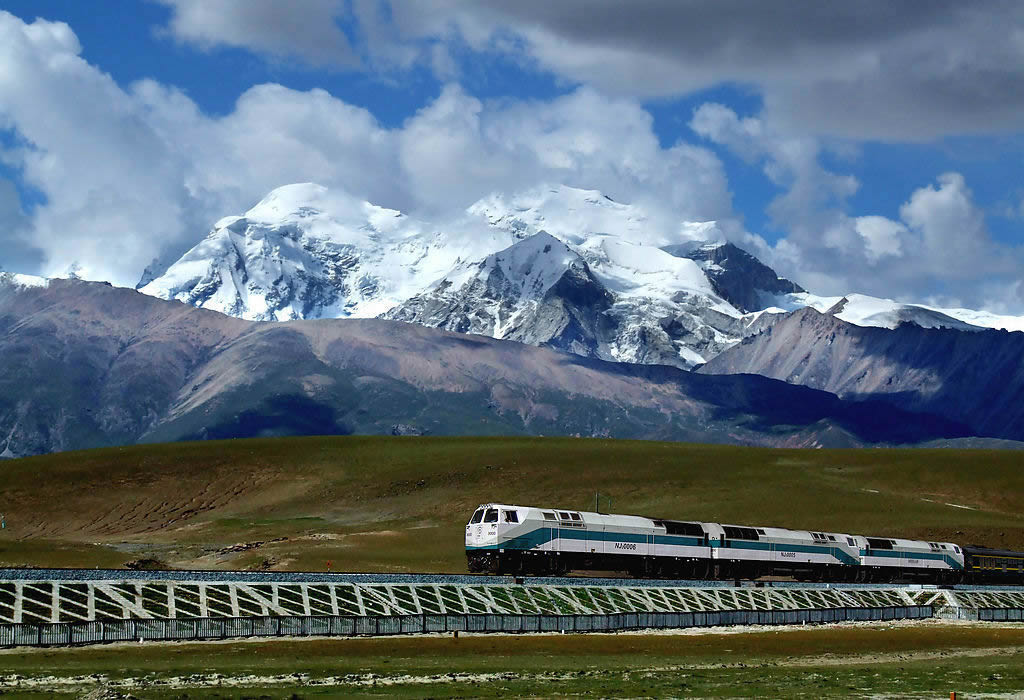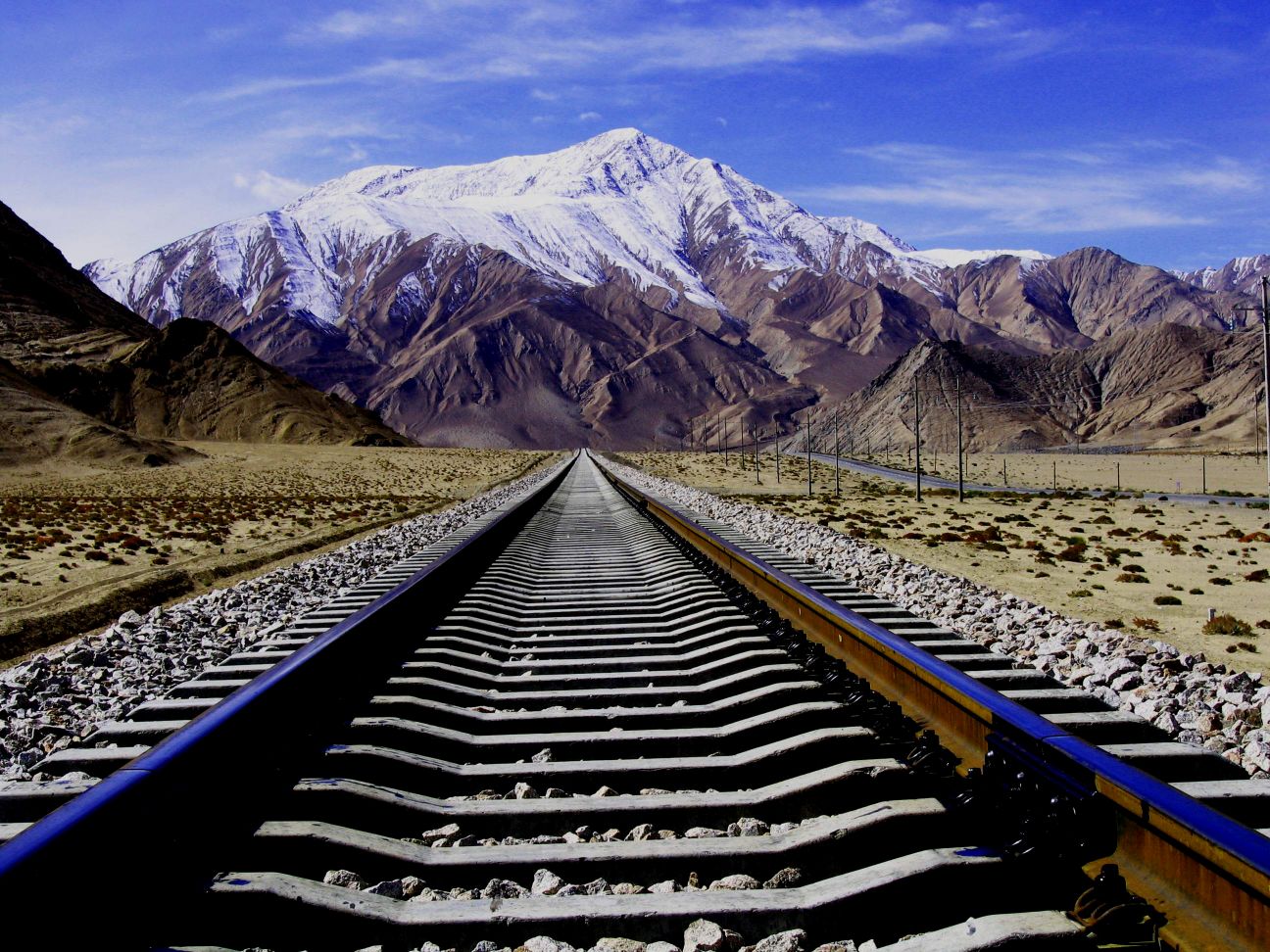Beijing To Lhasa - A Train Journey To The Top Of The World
It's three hours before the T27 is due to leave on a balmy Sunday night but at West Beijing Station, a vast railway nexus in China's bursting-at-the-seams capital, there's no such thing as "too early". Waiting is a game of musical chairs, with a soundtrack of shouted announcements about the imminent departure of other trains, until the platform gates open suddenly and I'm caught in a human tide flowing beside ours. When I see my carriage number, I breaststroke through the crowd to the door, where a guard politely checks not only my ticket but the all-important travel permit every foreigner must have to enter the Tibet Autonomous Region. Once inside, I keep swimming - with my luggage - down a carpeted corridor to my cabin and designated bunk.
This is soft-sleeper class and while it's nothing like platinum or even gold class on the Ghan, it is the most comfortable way to do the Beijing-Lhasa journey - at least until the new Tangula Luxury Train begins operating next year (see fast facts). Each small cabin has four bunks - my cabin mates are a Chinese man, a Tibetan woman and a Japanese man - and each bunk has a coathanger and a wall-mounted television with headphones (though the English-language content is oddly limited to Forrest Gump and 1930s Huckleberry Finn movies). Under the panoramic window, there's a folding table bearing a vacuum flask (to make tea and noodle soup using hot water from the end of the carriage), a vase of plastic tulips (which never falls over, a testimony to the smooth ride) and a complimentary magazine called China's Tibet.
It doesn't take long to discover that this train, in soft-sleeper class anyway, is a United Nations on rails: there are four Israeli women in the cabin next door, more Australians en route to Everest Base Camp, two Indian-born Singaporean couples bound for Nepal and some French honeymooners. All of us, it transpires, are making this journey for the first time and, as the train lurches into life at 9.30pm, right on schedule, there's a pause in the getting-to-know-you banter while the same thought occupies us: we're on our way to the roof of the world. The idea of a railway to the heart of Tibet was conceived in 1919 by Sun Yat-sen, the first president of the Republic of China. Mao Zedong further investigated its feasibility in 1955 but it wasn't until 1984 (eight years after Mao's death) that the first section of track was completed - an 814-kilometre stretch from Xining to Golmud, both in China's Qinghai province.
It took another 17 years for the real feat of construction to begin, in March 2001: the 1142-kilometre, high-altitude Golmud-to-Lhasa railway that former Chinese premier Zhu Rongji once called "an unprecedented project in the history of mankind". Built at a cost of $US4.2 billion, it employed 100,000 engineers and construction workers for four years - many of whom had to breathe bottled oxygen and endure temperatures of minus 45 degrees. Eighty-six per cent of the railway is higher than 4000 metres, 550 kilometres of track is laid on permafrost and the highest point is a lofty 5072 metres above sea level - almost as high as Everest Base Camp. As if that isn't impressive enough, the Qinghai-Tibet railway (so named because it runs between Xining, the capital of Qinghai province, and Tibet) holds nine world records, including highest railway in the world, highest train station (Tanggula Station, at 5068 metres above sea level) and highest railway tunnel (the 1.3-kilometre Fenghuoshan tunnel, at 4905 metres).
Most importantly, and controversially, when it was opened in July 2006, the railway line completed the 4064-kilometre apron-string between Beijing and the Tibet Autonomous Region. The Chinese government regards this new railway as a means of bringing economic development to "backward" Tibet and allowing access to valuable natural resources in the region: billions of dollars of more than 100 different minerals and river systems for hydroelectric schemes. Critics of the railway see it speeding up the dilution of Tibet's population with Chinese immigrants (accurate figures are hard to come by but human rights groups estimate that, in Lhasa alone, Han Chinese now outnumber Tibetans three to one) and turning Tibet's most revered temples and rituals into tourist attractions for the 5.5 million predominantly Chinese who now visit annually. (The government is hoping for 6 million visitors this year.)
Politics is far from my mind on our first morning, however. Because we'd boarded the train after dark and gone to bed soon after, I just want to look out the windows to see China in all its vast and populous glory. And here it is, right before my eyes. Imagine Australia, which is only marginally smaller, with a population of about 1.3 billion and it's not surprising that there is scarcely a square metre of land, at least within sight of the train, that hasn't been farmed, built on or mined. Every muddy river I see has several bridges reaching over it and dams along its length. Hazy hillsides are layer cakes of rice terraces. It doesn't help that the sky is a smoky grey and the landscape feint-ruled with power lines.
In contrast to this wide-screen world, the interior of the train is an exercise in confinement or, as Buddhist teachers might say (we are, after all, hurtling towards the spiritual capital of Tibetan Buddhism), "the wisdom of no escape". It's like a college dorm on rails, especially where the majority of my fellow passengers are accommodated - in the uninvitingly named "hard-sleeper" and "hard-seat" classes, which I stroll through after breakfast. Back there it's all unmade beds, kung fu movies on laptops, chain-smoking at the ends of the carriages, six bunks to a cabin and seats that don't recline. Except for one gent happily wandering around in flannelette pyjamas, everyone looks as if they're shaking off a long and sleepless night. There's also an air of resignation; for most of these travellers, this train ride is a means to an end: work, and possibly a new life, in Lhasa.
Returning to what now feels like first class, I pass the time by chatting to my cabin mates, sitting on a fold-out seat in the corridor gazing at the scenery and reading when the tunnels aren't plunging us into near-darkness for minutes at a time. At 4pm the train stops unexpectedly at Lanzhou station for a few minutes, long enough to get off, stretch our legs and breathe real air again. Then, in a gesture of neighbourliness, the four Israeli women invite me to squeeze into their cabin next door for afternoon tea and home-made biscuits. That first night, after dinner ("shrimp and black fungus" in the dining car), there's another diversion: the steward hands out passenger health declaration forms to sign. On the back are the Beijing Railway Administration's Plateau Travel Instructions, which advise against travelling above 3000 metres if you have heart disease, pulmonary oedema, asthma or a heavy cold, or if you are a "highly dangerous pregnant woman" or have "diabetes out of control, the hysteria, epilepsy [or] schizophrenia" (though there's no advice about what to do if you find yourself with one of these contraindications aboard a train speeding towards Tibet).
Later, in the pre-dawn darkness, I hear a whooshing sound coming from a small vent in the wall and my head simultaneously begins to ache - both signs that we are climbing on to the Tibetan Plateau, aka the Qinghai-Tibet Plateau, an enormous highland 3500 kilometres across, with an average elevation of 5000 metres. The trains aren't pressurised but they do have generators that pump oxygen-enriched air through all the carriages. Personal oxygen-breathing kits are also available (though I don't see anyone using one), consisting of a plastic tube that fits to your nostrils and connects to oxygen outlets above each bunk and throughout the train. My mild headache persists, along with a congested, head-cold feeling, but the new views on the morning of day two more than compensate for any discomfort. Gone are the farms, the mines and the high-rise apartment blocks; in their place is an infinite and empty flatness and, on the right side of the train, the snow-topped Kunlun Range. Piped piccolo music adds to the sense of wonder, until it's interrupted by a stern male voice broadcast on the PA.
"Dear passengers and friends," it begins, with an American accent. We're asked not to smoke (the oxygen-enriched air is highly flammable) and told we are entering the Kekexili Protection Area. We might see Tibetan antelopes, yaks, wild deer and brown bears, the man says, before signing off with a cheery "Let's enjoy the eyes please, provided by nature!" It's then that I notice something about my Tibetan cabin mate - she looks suddenly, noticeably brighter, despite the fact we are still in Qinghai province and not in the Tibetan Autonomous Region yet. So I ask her how she feels to be on the plateau. She smiles and says simply, "This is my homeland." Before 1951, Tibet comprised what is now the region and large areas that have since been absorbed into the Chinese provinces of Qinghai, Sichuan and Yunnan. To many Tibetans, however, Tibet remains as it was. Either way, the landscape has its own opinion - this is a very different place from the country we travelled through yesterday.
As we glide over permanently frozen earth on elevated tracks that ensure it stays that way, we see dark brown nomads' tents and men in hats sleeping on the grass beside their motorcycles. Pilgrims wearing leather aprons stop their prostrations along the road - China National Highway 109, which shadows us all the way from Golmud to Lhasa - to wave at us with wooden paddles on their hands. About noon, we speed past Tanggula Station, the highest railway station in the world. Passenger trains don't stop here, unfortunately, but we do stop briefly at nearby Naqu. I put on a warm jacket (it's 4 degrees outside) and walk around higher than I've ever been before: 4513 metres above sea level.
The thinness of the air is barely noticeable - until I try to walk and talk at the same time and feel as if I've just run for the train rather than walked three paces to step back on to it. The closer we get to Lhasa, the more Tibetan our surroundings become. There are prayer flags strung across glacial, fast-flowing rivers and streaming colourfully down steep hillsides; people dressed in chubas harvesting barley (a Tibetan staple) or resting beside yaks harnessed to primitive ploughs; and stone walls around old stone houses. Too soon, we're on a white, three-arch bridge crossing the Lhasa River and catching our first glimpse of the legendary Potala Palace, a few kilometres away, its whitewashed walls gleaming in the evening sunshine. Then, two hours ahead of schedule and just after 7pm, we disembark at Lhasa Railway Station, 3650 metres above sea level.
It has taken us 45 hours to travel across China from Beijing to this Buddhist city ringed by high mountains - more than a day and a half longer than the four-hour flight. But that's the beauty of long-distance train travel, especially when you're headed for Shangri-La: it slows down the speeding mind enough so when you arrive, you're ready to appreciate being on top of the world.
Louise Southerden
Apr 2 2010
www.smh.com.au
#asiatours #toursasia #traintours #china #tibet #tibettours #trainjourney #chinatours #multicountrytours #insighttoasiatours
Leave a comment
Leave a comment
You must be logged in to post a comment.


